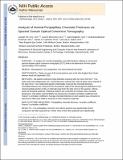| dc.contributor.author | Ho, Joseph | |
| dc.contributor.author | Branchini, Lauren | |
| dc.contributor.author | Regatieri, Caio | |
| dc.contributor.author | Krishnan, Chandrasekharan | |
| dc.contributor.author | Fujimoto, James G. | |
| dc.contributor.author | Duker, Jay S. | |
| dc.date.accessioned | 2015-12-17T01:07:40Z | |
| dc.date.available | 2015-12-17T01:07:40Z | |
| dc.date.issued | 2011-06 | |
| dc.date.submitted | 2011-02 | |
| dc.identifier.issn | 01616420 | |
| dc.identifier.uri | http://hdl.handle.net/1721.1/100403 | |
| dc.description.abstract | Purpose
To analyze the normal peripapillary choroidal thickness utilizing a commercial spectral domain optical coherence tomography (OCT) device and determine the intergrader reproducibility of this method.
Design
Retrospective, noncomparative, noninterventional case series.
Participants
Thirty-six eyes of 36 normal patients seen at the New England Eye Center between April and September 2010.
Methods
All patients underwent high-definition scanning with the Cirrus HD-OCT. Two raster scans were obtained per eye, a horizontal and a vertical scan, both of which were centered at the optic nerve. Two independent graders individually measured the choroidal thickness. Choroidal thickness was measured from the posterior edge of the retinal pigment epithelium to the choroid–scleral junction at 500-μm intervals away from the optic nerve in the superior, inferior, nasal, and temporal quadrants. Statistical analysis was conducted to compare mean choroidal thicknesses. Intergrader reproducibility was assessed by intraclass correlation coefficient and Pearson's correlation coefficient. Average choroidal thickness in each quadrant was compared with retinal nerve fiber layer (RNFL) thickness in their respective quadrants.
Main Outcome Measures
Peripapillary choroidal thickness, intraclass coefficient, and Pearson's correlation coefficient.
Results
The peripapillary choroid in the inferior quadrant was significantly thinner compared with all other quadrants (P<0.001). None of the other quadrants were significantly different from each other in terms of thickness. The inferior peripapillary choroid was significantly thinner compared with all other quadrants at all distances measured away from the optic nerve (P<0.001). Generally, the peripapillary choroid increases in thickness the farther it was away from the optic nerve and eventually approaching a plateau. The intraclass correlation coefficient ranged from 0.62 to 0.93 and Pearson's correlation coefficient ranged from 0.74 to 0.95 (P<0.001). Neither RNFL thickness nor average age was significantly correlated with average choroidal thickness.
Conclusions
Manual segmentation of the peripapillary choroidal thickness is reproducible between graders, suggesting that this method is accurate. The inferior peripapillary choroid was significantly thinner than all other quadrants (P<0.001). | en_US |
| dc.description.sponsorship | Research to Prevent Blindness, Inc. (United States) | en_US |
| dc.description.sponsorship | National Institutes of Health (U.S.) (RO1-EY11289-24) | en_US |
| dc.description.sponsorship | National Institutes of Health (U.S.) (R01-EY13178-10) | en_US |
| dc.description.sponsorship | National Institutes of Health (U.S.) (R01-EY013516-07) | en_US |
| dc.description.sponsorship | United States. Air Force Office of Scientific Research (FA9550-07-1-0101) | en_US |
| dc.description.sponsorship | United States. Air Force Office of Scientific Research (FA9550-07-1-0014) | en_US |
| dc.language.iso | en_US | |
| dc.publisher | Elsevier | en_US |
| dc.relation.isversionof | http://dx.doi.org/10.1016/j.ophtha.2011.02.049 | en_US |
| dc.rights | Creative Commons Attribution | en_US |
| dc.rights.uri | http://creativecommons.org/licenses/by-nc-nd/4.0/ | en_US |
| dc.source | PMC | en_US |
| dc.title | Analysis of Normal Peripapillary Choroidal Thickness via Spectral Domain Optical Coherence Tomography | en_US |
| dc.type | Article | en_US |
| dc.identifier.citation | Ho, Joseph, Lauren Branchini, Caio Regatieri, Chandrasekharan Krishnan, James G. Fujimoto, and Jay S. Duker. “Analysis of Normal Peripapillary Choroidal Thickness via Spectral Domain Optical Coherence Tomography.” Ophthalmology 118, no. 10 (October 2011): 2001–2007. | en_US |
| dc.contributor.department | Massachusetts Institute of Technology. Department of Electrical Engineering and Computer Science | en_US |
| dc.contributor.department | Massachusetts Institute of Technology. Research Laboratory of Electronics | en_US |
| dc.contributor.mitauthor | Fujimoto, James G. | en_US |
| dc.relation.journal | Ophthalmology | en_US |
| dc.eprint.version | Author's final manuscript | en_US |
| dc.type.uri | http://purl.org/eprint/type/JournalArticle | en_US |
| eprint.status | http://purl.org/eprint/status/PeerReviewed | en_US |
| dspace.orderedauthors | Ho, Joseph; Branchini, Lauren; Regatieri, Caio; Krishnan, Chandrasekharan; Fujimoto, James G.; Duker, Jay S. | en_US |
| dc.identifier.orcid | https://orcid.org/0000-0002-0828-4357 | |
| mit.license | PUBLISHER_CC | en_US |
| mit.metadata.status | Complete | |
